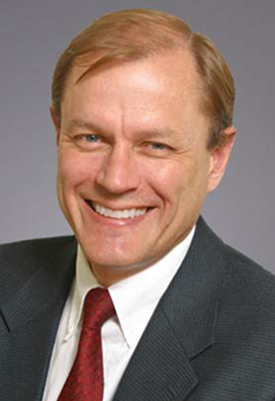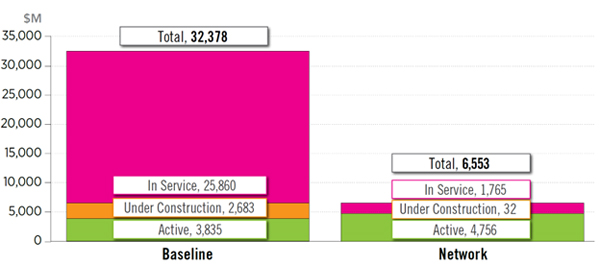
 Steve Huntoon | Steve Huntoon
Steve Huntoon | Steve HuntoonYes, federal policy needs to advance rational transmission grid expansion. We need AC interconnections between ERCOT and the rest of the country.[1] We need more — not less — competition in transmission.[2] And as I wrote in my last column (and before), we should apply unique emergency line ratings for planning/interconnection studies and deploy technologies that increase physical capacity of grid elements.[3] These are no-brainers that FERC continues to eschew.
Which brings me to what FERC is doing in its massive April Notice of Proposed Rulemaking on transmission planning and cost allocation (RM21-17). FERC says it begins with “facts on the ground.” Yes, let’s do!
NOPR Claim #1: Transmission Expansion isn’t Happening on a Regular Basis Through Regional Processes
The NOPR asserts that transmission expansion isn’t happening through regional planning processes on a regular or consistent basis and, “instead,” significant expansion is happening through upgrades constructed as a result of generator interconnection requests.[4]
Wrong, as this PJM chart shows: “Baseline” are planning process upgrades and “Network” are generator interconnection upgrades.[5] The former is $32.4 billion and the latter is $6.6 billion.

Moreover, the $32.4 billion in Baseline upgrades does not include individual transmission owner “supplemental projects,” of which there was $3.3 billion last year alone.[6]
It’s hard to figure out how the NOPR could have this “fact” so wrong, but it may stem from assuming that Baseline upgrades that are not cost allocated across a region somehow only provide “local” benefits. This leads us to:
NOPR Claim #2: Upgrades not Regionally Cost Allocated Don’t Provide System Benefits
The only upgrades in PJM that are always regionally cost allocated are 500-kV and above facilities (and double circuit 345-kV lines). There are many upgrades not regionally cost allocated that provide non-local benefits, including many upgrades that are below 200 kV, cost less than $5 million, are needed in three years or less, and/or relieve contingency violations that would otherwise reduce flow on higher voltage facilities.[7] Nor is the NOPR correct that upgrades not regionally cost allocated are not regionally planned[8] — all $32.4 billion in Baseline upgrades were regionally planned by PJM.
And regarding individual TO “supplemental projects,” these too can provide system benefits as described by PJM to include: “enhancing grid resilience and security, promoting operational flexibility [and] addressing transmission asset health.”[9]
The relatively small number of regionally cost allocated upgrades is a good thing. Why spend billions on a large 500-kV project when an upgrade of an existing transmission facility can relieve the reliability violation?
And non-regionally cost allocated upgrades surely provide no less system benefit than generator interconnection upgrades, which tend to be localized around the point of generator interconnection.
Having created an invalid preference for regionally cost allocated projects over other upgrades, the NOPR follows up by eliminating competition for the former on grounds that eliminating competition will incent transmission owners to pursue more of them.[10] Yikes!
NOPR Claim #3: Generator Interconnection Costs Have Seen a ‘Dramatic Increase’
The NOPR claims that interconnection costs for new generation in $/kw have seen a “dramatic increase.”[11] It arrives at this conclusion based on data from a selected MISO subregion and from PJM that conflate the upgrade cost per kW of actual projects with that cost for proposed projects.[12] Instead, what this data suggest is that participant funding serves to weed out proposed projects with uneconomic interconnection costs. A good thing.
When apples (earlier actual projects) are compared to apples (later actual projects), the source study by Lawrence Berkeley presents this chart, and comes to the opposite conclusion about interconnection costs over time. [13]
In the study’s own words: “These results combine the MISO, PJM, and EIA data to assess how location and queue date correlate with transmission costs. … There is little evidence of significant cost trends over time ….”[14]
In other words, the source study relied on by the NOPR says the opposite of what the NOPR says it says.
As for the NOPR’s poster child for high generator interconnection costs, it cites a 120-MW solar project in PJM and says that the project faced interconnection costs of $1.5 billion, including rebuilding 500-kV lines.[15] Needless to say it is easy to cherry pick one interconnection request out of 8,509 interconnection requests in PJM over the past 25 years.[16]
And lest we forget, those opposed to participant funding would force consumers to pay that $1.5 billion — rather than incent the project developer to find a lower cost interconnection point (or perhaps pursue another project).[17] Yikes!
NOPR Claim #4: Transmission Customers Unfairly Benefit from Generator Interconnection Upgrades
Here’s another “fact” that drives me up a wall. The NOPR says that generator-paid upgrades can create system benefits for transmission customers who don’t pay for the upgrades.[18] This claimed benefit is more capacity, aka “headroom” on transmission circuits.
This is possible but, as I’ve pointed out before,[19] ignores the fact that a generator benefits for free from all the headroom that already exists on circuits because of past upgrades paid for by transmission customers. There is zero point zero evidence that the headroom created by generator upgrades is more valuable to transmission customers than the headroom created by transmission customers’ upgrades that generators benefit from.[20]
Bottom Line
We need rational transmission policies (like the ones I identified at the outset). Let’s base policies on real facts.
[2] https://www.energy-counsel.com/docs/FERC-Order-1000-Need-More-of-Good-Thing.pdf. More on this later.
[4] Docket No. RM21-17-000, issued April 21, ¶ 36: “Significant expansion of the transmission system instead appears to occur through interconnection-related network upgrades constructed as a result of generator interconnection requests.” (emphasis added, footnote omitted).
[6] https://pjm.com/-/media/documents/ferc/filings/2022/20220613-pjm-supplemental-comments-on-doe-noi-on-tfp.ashx, page 7, footnote 17. By one tally, supplement project costs since 2005 have exceeded $41 billion.
[7] This last category may be a result of the change in 2013 to a solution-based DFAX methodology that allocates costs based on loadings of the lower voltage solution instead of loadings on the higher voltage facility whose outage causes the violation. https://elibrary.ferc.gov/eLibrary/filedownload?fileid=01A68F74-66E2-5005-8110-C31FAFC91712 The loadings on the lower voltage solution tend to be limited to a single transmission owner zone.
[8] “ … regional transmission planning and cost allocation processes generally have resulted in few regionally planned transmission facilities being selected and ultimately built.” NOPR ¶ 245.
[9] Footnote 6, pages 6-7.
[10] NOPR ¶ 353.
[11] NOPR ¶ 37, 38, 162.
[12] The discussion of MISO and PJM costs in NOPR ¶ 38 relies on Figure 2 of a MISO document here, https://cdn.misoenergy.org/20200520%20AC%20Item%2004%20Current%20Issue%20-%20Generator%20Interconnection%20Queue447230.pdf, and Table 2 of the Lawrence Berkeley National Laboratory study here, https://www.sciencedirect.com/science/article/abs/pii/S0301421519305816?via%3Dihub. (click on “View Open Manuscript”). Regarding the MISO data please note that data for most of the other MISO subregions do not support the NOPR’s claim — even if the data were apples to apples (which they’re not).
[13] Figure 6, page 46, of the above Lawrence Berkeley study.
[14] Page 17 of the above Lawrence Berkeley study (emphasis added).
[15] NOPR ¶ 38 and footnote 58. The subject feasibility study is here, https://pjm.com/pub/planning/project-queues/feas_docs/ae1135_fea.pdf.
[17] My full take on participant funding is here: https://www.energy-counsel.com/docs/participant-funding-and-its-discontents.pdf.
[18] NOPR ¶ 165.
[19] Column referenced in footnote 17.
[20] Conversely, if generators can shift interconnection costs to consumers on the assumption of headroom benefit to consumers then generators should pay for the headroom they presently get for free.